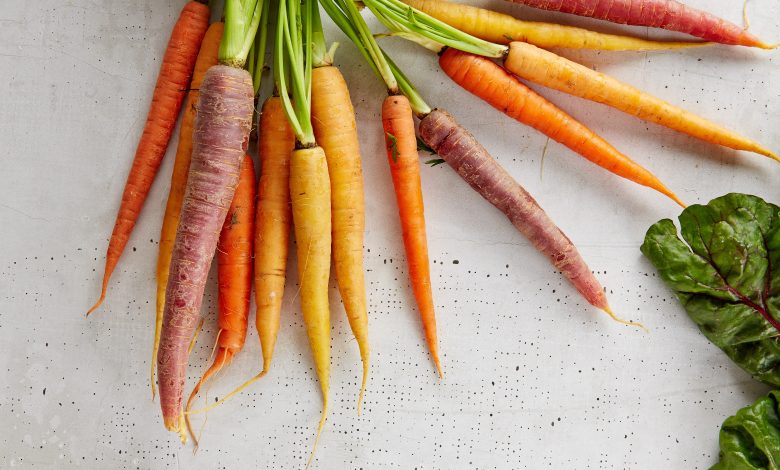
The Best Root Vegetables To Prevent Weight Gain
A lot of people who are trying to lose weight and get healthier feel scared when they hear the term root vegetables. In their minds, there is often an instant association with something ‘heavy’ that will cause them to pile on pounds. This is not actually the reality though.
A root vegetable is one that grows underground, near the plant base. If you think in absolute technical terms, they aren’t all roots; a couple of them are simply bulbous growths which store nutrients for feeding plants in winters. Examples include: corms (water chestnut and celery root); bulbs (fennel onions); tuberous roots (yucca and sweet potato); and tap roots (carrots and beets).
Most of you might be surprised to know that root vegetables aren’t really calorie dense. They contain a high amount of antioxidants, minerals, and vitamins and minimal calories. The fact that they have lots of fiber means that they help you feel fuller for longer and hence prevent unnecessary snacking or overeating throughout the day.
Each type of root vegetable has a distinctive health benefit, and to help you stay fit, we’re listing ten of the best root vegetables that you can include in your daily diet to prevent weight gain.
Onions
It is true that onions are used to cook several dishes, including curries, pies and soups. The popularity of this root vegetable is recognized across cuisines from all over the world. Onions have high amounts of fiber (excellent for weight loss), antioxidants, and vitamin C. There is research to suggest that including onions in your diet could boost your health in different ways. For instance, it may bring down the levels of blood sugar in your body, which is particularly helpful for people with diabetes.
The fiber in onions ensures that the gut remains healthy, which is vital when you’re trying to lose weight. There are studies to show that this root vegetable might play a significant role in effecting fat loss, especially near the belly. Onions are pretty versatile and can be consumed raw, cooked, or baked to put in all kinds of dishes.

Sweet Potatoes
If you go to a nutritionist or dietician, they will surely point you towards sweet potatoes as a choice of root vegetable that aids weight loss. Besides being an excellent source of vitamin C, B5 and A and potassium, sweet potatoes are supremely tasty. They also contain fiber and a type of starch that slowly gets absorbed in your body. The health benefits of this root vegetable don’t end here. It is rich in phytonutrients (antioxidants), including anthocyanins and chlorogenic acid. The name sounds misleading, but sweet potatoes actually rank pretty low in the glycemic index (GI) as compared to white potatoes. This is the reason why they help in stabilizing your blood sugar levels.
Carrots
Carrots are yet another variety of root vegetable that contains high amounts of dietary fiber. The reason we’re stressing on this advantage is because fiber typically takes a while to digest and allows you to feel adequately satiated. This automatically leads to less frequent eating and the desire to consume smaller portions. If you’re someone who craves junk food, then carrots are a great vegetable to include in your diet. You can have them raw as sticks with a light dip like hummus or homemade hung yogurt. You’d be happy to know that this root vegetable has less calories and isn’t naturally starchy. If not as a snack, you can put carrots in your soups, smoothies, or salads.
Beets
The calorie content of beets is quite low (44 calories per 100 gram serving), and they contain some very valuable minerals and vitamins. Beets are an excellent root vegetable to include in your weight loss diet and have one of the highest antioxidant levels among vegetables, besides pepper and broccoli. They contain betalain, a unique phytonutrient, and are known to enhance your stamina during exercise and athletic performances. They also aid quick muscle recovery, improve circulation, and minimize inflammation.
Like several other root veggies, beets are a good source of fiber and therefore enhance digestion. They promote the growth of healthy gut bacteria and also add to the bulk of the stool. For those suffering from constipation and associated weight gain, including beets in your diet, as a whole vegetable or juice, might be highly beneficial.
Butternut Squash
There is no denying the fact that consuming butternut squash in the fall has several health benefits. Plus, this root vegetable contains only 80 calories per cup and provides over 200 percent of your daily recommended intake of vitamin A. It is also a good source of vitamin C. If sweet potatoes aren’t your favorite veggie, you could easily replace them with butternut squash since they’re have even less calories (this does not mean you need to forgo eating sweet potatoes).
One of the best ways to eat butternut squash is as puree in soup. It will make the dish just the right amount of creamy without adding the extra fat or calories. Other options include roasting the squash cubes till they’re nice and tender and seasoning them with your choice of spice mix. Ever heard of squash noodles? Just sauté the spiralized version of the veggie in a pan with some hot sauce and top with cheese.
Turnips
Turnips are creamy white in color from the inside and have a purple exterior. There is a tendency to categorize this European staple vegetable with beetroot and sweet potatoes, but in reality, turnips are akin to Brussel sprouts, kale, and broccoli. This popular root vegetable is rich in vitamins and sulfur, which are needed for producing energy in the body and ensuring good metabolism. At the same time, turnips have a minimum calorie count and can easily be included in your weight loss diet. You can eat them in the raw form as part of salads, blend them into soups, and sauté or roast them to eat with greens.

Radishes
It might be safe to say that radish is an acquired taste and that not everyone loves this root vegetable. However, the tiny root veggie is packed with nutrients and has very low carbohydrate content. Radishes are pretty low in calories too and are rich in vitamin C and fiber. They are known for their antifungal properties and can prevent stomach ulcers.
Radishes may be small, but they manage to pack a punch when it comes to nutrition. Because of the high water and fiber content, this root vegetable helps you feel fuller for longer. A radish is a great way to add some crunch and bite to your snacks and meals. You could add a couple of slices to your salads, tacos, or sandwiches or grate them into your slaw. It will not only make for a tasty upgrade, but will also make your dish even more nutritious.
Celeriac
As compared to other root vegetables, celeriac is relatively unknown, though it is rapidly increasing in popularity today. Loaded with some vital minerals and vitamins, celeriac provides multiple health benefits and is quite a versatile vegetable to include in your daily diet. In fact, it could easily replace potatoes as a side dish on your plate. The root veggie is very similar to celery, parsnips, and parsley.
100 grams of cooked celeriac gives you just about 6 grams of carbohydrates, which, as mentioned earlier, makes it a much healthier alternative to white potatoes. A fresh, 100 grams serving of celeriac, on the other hand, contains only 42 calories, so you can easily add it to your salad or sandwich.
Rutabaga
This name may not sound too familiar, but rutabaga is one of the most delicious root vegetables that you can get your hands on. If you haven’t tasted it yet, you’re really missing out.
In technical terms, rutabaga is a mix of a turnip and cabbage and is extremely juicy and crispy. It has a mild taste, which makes it appealing to most taste buds. A lot of people like to mash this vegetable with cream and milk, just how they cook potatoes. They might even add a few chunks of rutabaga to their mashed potatoes. Rutabagas can add flavor and color to any dish and also uplift its taste.
One of the best things about rutabagas is that they don’t put pressure on your gut. This is because they contain high amounts of soluble fiber and very little insoluble fiber.
Yams
Yams (scientific name ‘dioscorea’) fall in the category of tuber vegetables that have their origin in the Caribbean, Asia and Africa. Often people mistake sweet potatoes for yams and vice-versa; however, they’re two distinct vegetables. Yams are known to have more starch and have less natural sugar. The exterior of the root vegetable resembles a tree’s bark with its distinct brown color. Depending on a particular yam’s maturity, its flesh could be pink, purple, yellow, or white in color. The vegetable is rich in fiber, minerals, and vitamins and has several health benefits.
A cup of the root veggie yields just about 158 calories, 37 grams of carbohydrates, and 0 grams of fat. Besides being an excellent fiber source, yams contain high amounts of manganese and potassium, minerals that are critical for growth, bone health, heart function, and metabolism. The tubers also have decent quantities of vitamin C and copper.
There are studies to show that yams may have the effect of improving one’s levels of blood sugar. In one of them, rats were given yam water or yam powder extract and experienced reduced hemoglobin A1c and blood sugar (fasting) levels. According to another study, rats that were fed purple yam in significant quantities demonstrated reduced appetites and weight loss.
Yams contain something known as a resistant starch, which passes through the gut undigested. It is linked to multiple health benefits like decreased appetite, balanced blood sugar, and improved insulin sensitivity.
Below are some simple ways to include yams in your regular diet:
- Purée: Boil yams until they’re soft and put inside a blender. Once puréed, season them and use as dressing or in curries.
- Yam fries: A great alternative to regular potato fries, yam fries are pretty simple and quick to make, plus super healthy. Cut the root vegetable to make wedges and add some seasoning. Now fry or bake them, as per your liking.
- Mashed yams: Mashed potatoes hindering your weight loss? Switch to mashed yams. Peel the vegetable, boil, and then mash it. Add seasoning and milk, and your mashed yams are ready.
- Yam chips: Instead of cutting the yams into thick wedges, slice them into thin chips and dry or bake to eat as a healthy snack.
- Baked yams: Looking for a healthy side dish to replace white potatoes? Cube your yams, and bake them till tender – less carbs, more nutrition, and no weight gain.
Think of root vegetables as whole, fresh foods that are rich in minerals and vitamins. When you eat a variety of them, you can experience several health benefits. For those who are healthy, it would be safe to eat one root vegetable serving every day. You just need to ensure that it is either a part of a dish or eaten as a side dish. In other words, it should not be the extra starch in your meal but the only one. So for instance, if you’re already eating rice, avoid adding sweet potatoes or yams to your plate.
If you aren’t much of a cook and want easy ways of incorporating root vegetables in your diet, them simply boil, bake, or mash them using some olive oil. But if you love cooking, feel free to get creative and try different ways of preparing root vegetables. You could use a slightly different cooking technique like searing, barbecuing or braising, and add some interesting flavors to your root vegetables.



